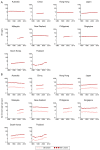Incidence and mortality of female breast cancer in the Asia-Pacific region
- PMID: 25009752
- PMCID: PMC4069805
- DOI: 10.7497/j.issn.2095-3941.2014.02.005
Incidence and mortality of female breast cancer in the Asia-Pacific region
Abstract
Objective: To provide an overview of the incidence and mortality of female breast cancer for countries in the Asia-Pacific region.
Methods: Statistical information about breast cancer was obtained from publicly available cancer registry and mortality databases (such as GLOBOCAN), and supplemented with data requested from individual cancer registries. Rates were directly age-standardised to the Segi World Standard population and trends were analysed using joinpoint models.
Results: Breast cancer was the most common type of cancer among females in the region, accounting for 18% of all cases in 2012, and was the fourth most common cause of cancer-related deaths (9%). Although incidence rates remain much higher in New Zealand and Australia, rapid rises in recent years were observed in several Asian countries. Large increases in breast cancer mortality rates also occurred in many areas, particularly Malaysia and Thailand, in contrast to stabilising trends in Hong Kong and Singapore, while decreases have been recorded in Australia and New Zealand. Mortality trends tended to be more favourable for women aged under 50 compared to those who were 50 years or older.
Conclusion: It is anticipated that incidence rates of breast cancer in developing countries throughout the Asia-Pacific region will continue to increase. Early detection and access to optimal treatment are the keys to reducing breast cancer-related mortality, but cultural and economic obstacles persist. Consequently, the challenge is to customise breast cancer control initiatives to the particular needs of each country to ensure the best possible outcomes.
Keywords: Asia-Pacific region; epidemiology; female breast cancer; incidence; mortality.
Conflict of interest statement
No potential conflicts of interest are disclosed.
Figures




References
-
- Agarwal G, Pradeep PV, Aggarwal V, Yip CH, Cheung PS. Spectrum of breast cancer in Asian women. World J Surg 2007;31:1031-1040 - PubMed
-
- Bhoo-Pathy N, Yip CH, Hartman M, Uiterwaal CS, Devi BC, Peeters PH, et al. Breast cancer research in Asia: adopt or adapt Western knowledge? Eur J Cancer 2013;49:703-709 - PubMed
-
- Parkin DM. The global burden of cancer. Semin Cancer Biol 1998;8:219-235 - PubMed
-
- Jemal A, Bray F, Center MM, Ferlay J, Ward E, Forman D. Global cancer statistics. CA Cancer J Clin 2011;61:69-90 - PubMed
-
- Youlden DR, Cramb SM, Dunn NA, Muller JM, Pyke CM, Baade PD. The descriptive epidemiology of female breast cancer: an international comparison of screening, incidence, survival and mortality. Cancer Epidemiol 2012;36:237-248 - PubMed
LinkOut - more resources
Full Text Sources
